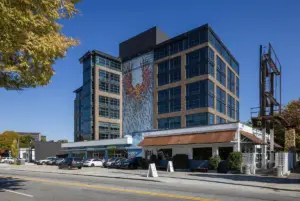In addition to our normal news coverage, What Now Atlanta is tracking ways Atlanta’s businesses are adapting to the novel coronavirus and the challenges it brings to brick-and-mortars.
Sign up now to get our Daily Breaking News Alerts
Mayor Keisha Lance Bottoms Wednesday announced that the City has “met the metrics” to progress from Phase I (“Stay at Home”) to Phase II (“Easing”) of the City’s five-phased reopening plan, drawn from the recommendations of the Mayor’s Advisory Council for Reopening Atlanta.
The City’s reopening plan is superseded by that of Georgia Gov. Brian Kemp who by May 31 will have completely allowed all businesses to reopen.
“As of May 24, 2020, Atlanta sustained the necessary 14-day downward trend in COVID-19 new cases, hospitalizations, and percent of positive test cases while maintaining sufficient hospital and critical care bed capacity to progress into Phase II, the ‘Easing’ phase,” according to Wednesday’s announcement.
“This phase does not include reopening the City of Atlanta government facilities.”
Starting Thursday, May 28, the City will begin bi-weekly reporting on progress towards meeting the Phase II “gate-keeping metrics” and each report will be posted on the ATLstrong.org website.
“As we continue to monitor the effects of COVID-19, we are now prioritizing a safe transition into Phase II of our reopening plan,” Bottoms said.
“Data shows that we are in a position to move forward. We encourage Atlantans citywide to continue to follow all precautionary guidelines as community transmission of COVID-19 still poses a threat to our city. As One Atlanta, we will continue to examine data developments and keep the necessities of cautiousness and vigilance at the forefront of our decision-making for the well-being of all those that call Atlanta home.”
During Phase II—the “Easing” phase—the City proposed the following guidelines:
Individuals:
Stay home except for essential trips
Wear face coverings in public
Frequent hand washing
Social distancing
Small, private gatherings of no more than 10 people, with social distancing
Businesses/Non-Profits:
To-go and curbside pickups from restaurants and retail establishments
Continue practicing teleworking
Frequent cleaning of public and high touch areas
City Government:
Non-essential City facilities remain closed
Continue moratorium on special event applications
Continue communication with local and State authorities to monitor public health metrics
“In order to leave Phase II, two critical gate-keeping measures have been added for contact tracing and testing capacity,” according to the announcement.
“The City of Atlanta will continue to Phase III after reaching and sustaining Phase II metrics. If there is a sustained increase in new COVID-19 cases or hospital or critical care capacity falls below 50 percent, the City will revert back to Phase 1.”
[Editor’s note: The novel coronavirus (COVID-19) pandemic is rapidly evolving as is its effect on Atlanta, and the City’s businesses and its residents. Click here for What Now Atlanta’s ongoing coverage of the crisis. For guidance and updates on the pandemic, please visit the C.D.C. website.]







15 Responses
Now that all the Memorial Day Weekend partiers have returned home, it will be interesting to see what the numbers look like in three weeks.
I feel like I’ve heard this before “Now that the governor has opened up the state, it will be interesting to see what the numbers look like in 2 weeks” Spoiler alert: There haven’t been massive increases.
It’s true, and I have been watching the same thing and will continue to do so. I have also seen a bit of data manipulation from the State, so I am also concerned about an “oops we forgot to update this correctly” moment.
Also, as people continue to let their guard down because “hey looks really safe now” despite nothing about the virus changing and many many people still actually staying home, there are a lot of factors at play if everyone just “got back to normal”. One small church had dozens of cases opening for one week with 25-30% physical attendance way out near Rome, so, yeah. Staying vigilant.
Well honey, I guess I should’ve conferred with you before I posted my comment.
As we keep getting more data, how about these numbers: the CDC slashed its infection fatality rate estimate below 0.3 percent and analyses show nursing homes account for 40-50% of all Covid deaths in the US. Taken together, I believe it’s factually accurate to say that if you’re not in a nursing home, the Coronavirus does not present significantly more risk than the flu.
The nursing home situation is mind numbing. New York was (allegedly) moving patients INTO nursing homes for treatment, and also moving patients from nursing homes to hospitals for treatment. If true, it’s no wonder things got so ugly.
I wonder if KLB was politically disappointed that we haven’t had a catastrophic surge in deaths after Kemp’s grandstanding.
I totally agree that the coronavirus for most people is no worse than the flu if you’re not a high risk patient. Also, I think it’s best to keep in mind that many hospitals across the country are empty and some have even furloughed doctors and nurses. My mom said she actually witnessed a completely empty testing site at Atlanta Medical Center and even the staff there looked bored and depressed
I don’t know what your expertise is, but the statement that “if you’re not in a nursing home, the Coronavirus does not present significantly more risk than the flu.” is a ridiculously ignorant statement. There are many people among the greater than 100,000 deaths in the US that were young, vibrant people prior to contracting the virus. We still don’t know the long term effects of prolonged ventilation in patients with the virus. Statements like yours are truly dangerous. How Trump-like!
I guess it depends on what you mean by “many” young and vibrant people. If you mean more than one, then yes, if you mean statistically significant, then no. The CDC data lags a bit:
Of the first 69k deaths cataloged, only 1,725 were under age 45. That’s 2.5%.
Only 7% of all deaths are attributed solely to Covid, while among the other 93% there are an average of 2.5 comorbidities.
https://www.cdc.gov/nchs/nvss/vsrr/covid_weekly/index.htm
It’s really not debatable at this point. Covid is hugely dangerous for older people and people with chronic health issues, especially respiratory or immune system related. Covid is not a significant threat to anyone under age 45 who does not have other medical issues.
Its funny how you are presenting dying as the only negative outcome from getting covid-19. There are many reports of patients that didn’t die but had significant or life changing damage from the disease. Take this report showing ~30% of hospitalized patients having kidney damage from the disease. And yes, hospitalized patients would include younger healthier people.
https://www.hopkinsmedicine.org/health/conditions-and-diseases/coronavirus/coronavirus-kidney-damage-caused-by-covid19
If the statistics make you want to change the conversation from fatalities to hospitalizations, the same analysis applies.
Again per CDC data, overall hospitalization rate of 4.6 per 100,000, 75% older patients, and 90% had underlying medical conditions.
https://www.cdc.gov/mmwr/volumes/69/wr/mm6915e3.htm
Simply not true. The comorbities are exactly that, not “the” cause of death. It just infers that they are at greater risk. You can make numbers say anything that you like, but the facts are that this is not “simply like the flu in the general population”
The numbers are what they are, I’m not making them say anything.
People seem to have an extremely hard time understanding statistics.
The city has already been open (for better or worse). Try to keep up.
Here’s to hoping Joe Biden can save us all from this simpleton and pick KLB to be his VP so she resigns her post and we can get a competent mayor.
YAAASSSSSSS